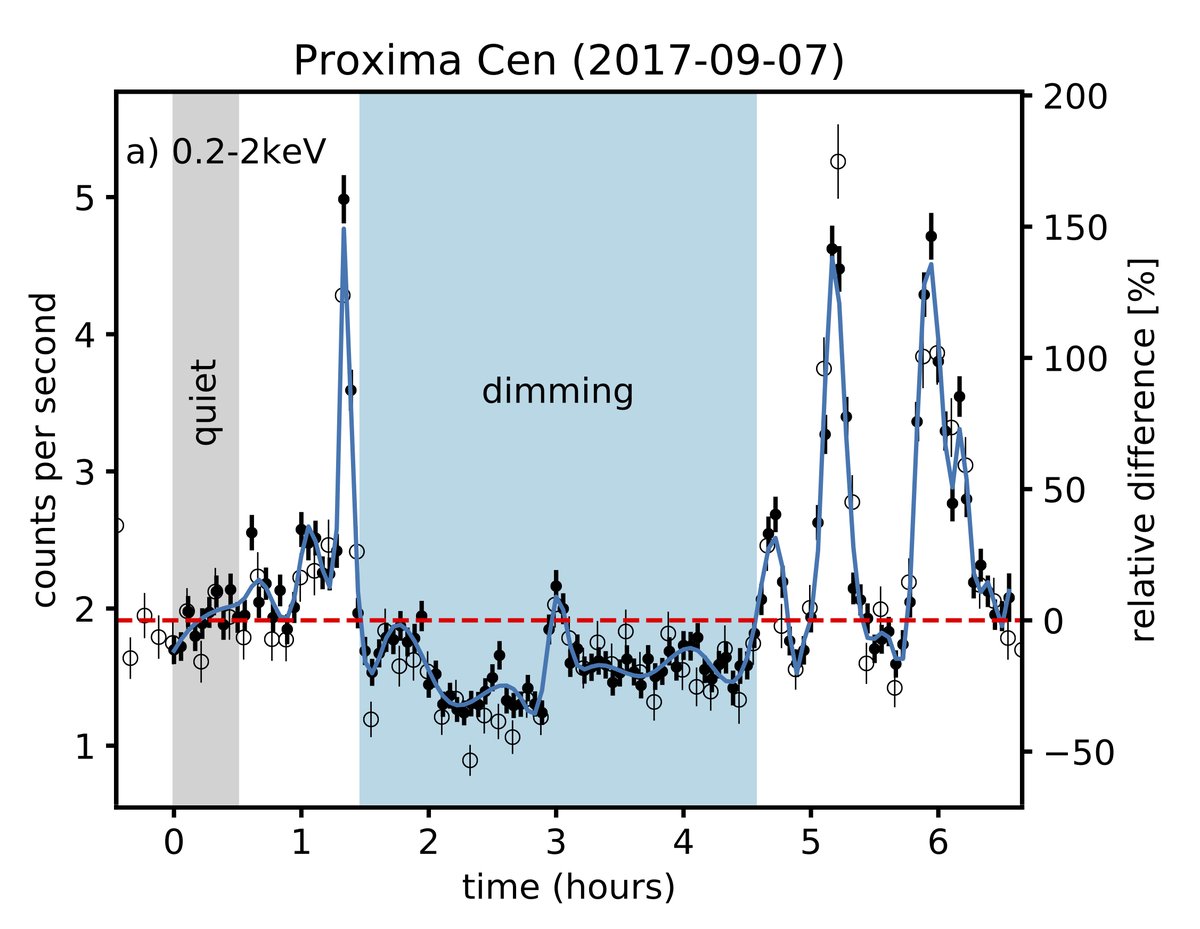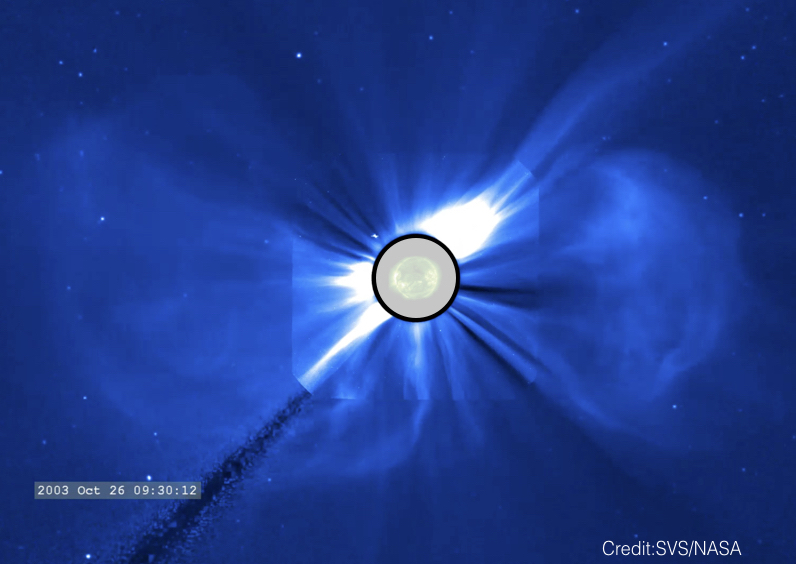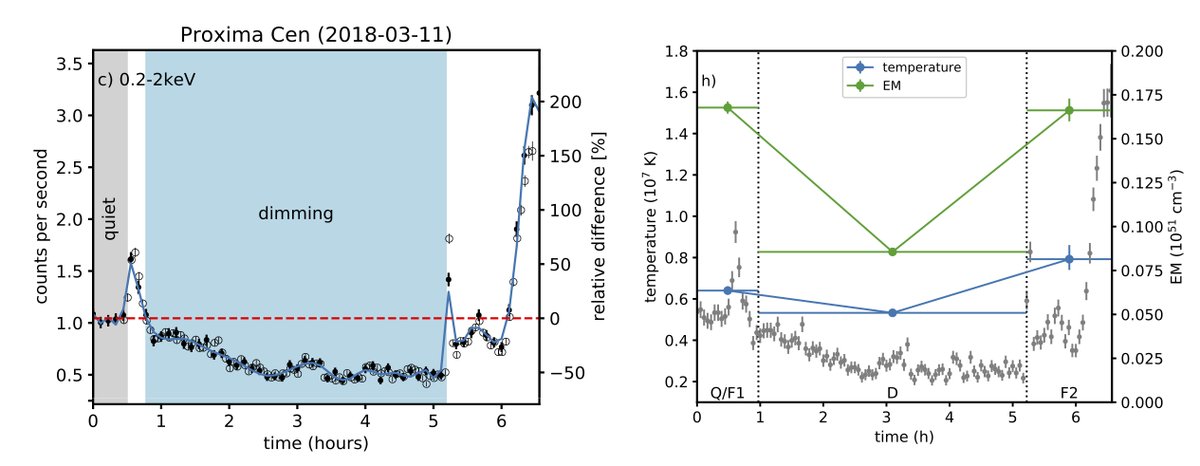Very excited to share that our paper on the first detections of post-flare dimmings on stars indicative of stellar coronal mass ejections (CMEs) was published in @NatureAstronomy yesterday! https://abs.twimg.com/emoji/v2/... draggable="false" alt="🥳" title="Partying face" aria-label="Emoji: Partying face">
https://abs.twimg.com/emoji/v2/... draggable="false" alt="🥳" title="Partying face" aria-label="Emoji: Partying face">  https://abs.twimg.com/emoji/v2/... draggable="false" alt="☀️" title="Sonne mit Strahlen" aria-label="Emoji: Sonne mit Strahlen">
https://abs.twimg.com/emoji/v2/... draggable="false" alt="☀️" title="Sonne mit Strahlen" aria-label="Emoji: Sonne mit Strahlen"> https://abs.twimg.com/emoji/v2/... draggable="false" alt="⭐️" title="Mittelgroßer Stern" aria-label="Emoji: Mittelgroßer Stern">
https://abs.twimg.com/emoji/v2/... draggable="false" alt="⭐️" title="Mittelgroßer Stern" aria-label="Emoji: Mittelgroßer Stern"> https://abs.twimg.com/emoji/v2/... draggable="false" alt="💨" title="Staubwolke" aria-label="Emoji: Staubwolke"> https://www.nature.com/articles/s41550-021-01345-9">https://www.nature.com/articles/... #StellarDimming @UniGraz #IGAMGraz #FFG @fwf_at 1/12
https://abs.twimg.com/emoji/v2/... draggable="false" alt="💨" title="Staubwolke" aria-label="Emoji: Staubwolke"> https://www.nature.com/articles/s41550-021-01345-9">https://www.nature.com/articles/... #StellarDimming @UniGraz #IGAMGraz #FFG @fwf_at 1/12
#CMEs are huge expulsions of magnetized matter from the #Sun & stars, propagating through space with speeds of millions of km/h. Solar CMEs can cause severe space weather disturbances & power outages on Earth  https://abs.twimg.com/emoji/v2/... draggable="false" alt="🌍" title="Europa-Afrika auf dem Globus" aria-label="Emoji: Europa-Afrika auf dem Globus">, stellar CMEs may pose a hazard to the habitability of #exoplanets.
https://abs.twimg.com/emoji/v2/... draggable="false" alt="🌍" title="Europa-Afrika auf dem Globus" aria-label="Emoji: Europa-Afrika auf dem Globus">, stellar CMEs may pose a hazard to the habitability of #exoplanets.
CMEs ejected by our Sun can be directly imaged by white-light coronagraphs, but for stars this is not possible. So far, only a few candidates for stellar CME detections have been reported.
Here, our approach is based on sudden post-flare dimmings in the EUV and X-ray emission caused by the CME mass loss. For the Sun, coronal dimmings are well established as a distinct footprint left behind by CMEs in both imaging data and full-Sun irradiance lightcurves.
For a set of 44 large #flares of class >M5.0 we derive broad-band Sun-as-a-Star EUV lightcurves from @dynamics_solar /EVE spectra, investigate them for the occurrence of dimmings, and check observations from #NASA’s STEREO spacecraft for associated CMEs.
The chances for a CME to occur when a dimming was identified after a large flare is as high as 97%, while the probability that a dimming occurs without a CME is only 17%.
This is strong evidence that dimmings are a robust proxy for CMEs, setting the stage to apply this technique to solar-like stars.
Our search was focused on Sun-like and late-type (F,G,K,M) main-sequence and pre-main sequence stars. We explored data archives of missions operating at EUV ( #NASA’s EUVE) as well as soft X-ray wavelengths ( @ESA_XMM and #NASA’s @chandraxray ) compiling observations of 201 stars.
Out of this plethora of observations, 21 stellar dimmings associated with flares on 13 different cool stars were observed, including our nearest neighbor #ProximaCentauri, with dimming depressions up to 50%.
Our study builds the foundation for a new approach of detecting stellar CMEs. Extending it towards estimations of their masses and speeds could help us to quantify the contribution of CMEs to the mass and angular momentum loss of stars and atmospheric escape of exoplanets.
Future missions at EUV and X-ray wavelengths with higher sensitivity, such as #ESCAPE #mission, are expected to provide us with many more coronal dimming observations, to be used for stellar CME detections and characterization of their parameters.
Are you still here? You made it to the end, hooray! https://abs.twimg.com/emoji/v2/... draggable="false" alt="🥳" title="Partying face" aria-label="Emoji: Partying face"> Full-text-view-only link to the paper: https://rdcu.be/cjbGn
https://abs.twimg.com/emoji/v2/... draggable="false" alt="🥳" title="Partying face" aria-label="Emoji: Partying face"> Full-text-view-only link to the paper: https://rdcu.be/cjbGn
Link">https://rdcu.be/cjbGn&quo... to the german press release: https://news.uni-graz.at/de/detail/article/ferne-sterne/">https://news.uni-graz.at/de/detail...
Link">https://rdcu.be/cjbGn&quo... to the german press release: https://news.uni-graz.at/de/detail/article/ferne-sterne/">https://news.uni-graz.at/de/detail...
Full list of authors: Astrid M. Veronig, Petra Odert, Martin Leitzinger, Karin Dissauer, Nikolaus C. Fleck, Hugh S. Hudson

 Read on Twitter
Read on Twitter https://abs.twimg.com/emoji/v2/... draggable="false" alt="☀️" title="Sonne mit Strahlen" aria-label="Emoji: Sonne mit Strahlen">https://abs.twimg.com/emoji/v2/... draggable="false" alt="⭐️" title="Mittelgroßer Stern" aria-label="Emoji: Mittelgroßer Stern">https://abs.twimg.com/emoji/v2/... draggable="false" alt="💨" title="Staubwolke" aria-label="Emoji: Staubwolke"> https://www.nature.com/articles/... #StellarDimming @UniGraz #IGAMGraz #FFG @fwf_at 1/12" title="Very excited to share that our paper on the first detections of post-flare dimmings on stars indicative of stellar coronal mass ejections (CMEs) was published in @NatureAstronomy yesterday!https://abs.twimg.com/emoji/v2/... draggable="false" alt="🥳" title="Partying face" aria-label="Emoji: Partying face"> https://abs.twimg.com/emoji/v2/... draggable="false" alt="☀️" title="Sonne mit Strahlen" aria-label="Emoji: Sonne mit Strahlen">https://abs.twimg.com/emoji/v2/... draggable="false" alt="⭐️" title="Mittelgroßer Stern" aria-label="Emoji: Mittelgroßer Stern">https://abs.twimg.com/emoji/v2/... draggable="false" alt="💨" title="Staubwolke" aria-label="Emoji: Staubwolke"> https://www.nature.com/articles/... #StellarDimming @UniGraz #IGAMGraz #FFG @fwf_at 1/12" class="img-responsive" style="max-width:100%;"/>
https://abs.twimg.com/emoji/v2/... draggable="false" alt="☀️" title="Sonne mit Strahlen" aria-label="Emoji: Sonne mit Strahlen">https://abs.twimg.com/emoji/v2/... draggable="false" alt="⭐️" title="Mittelgroßer Stern" aria-label="Emoji: Mittelgroßer Stern">https://abs.twimg.com/emoji/v2/... draggable="false" alt="💨" title="Staubwolke" aria-label="Emoji: Staubwolke"> https://www.nature.com/articles/... #StellarDimming @UniGraz #IGAMGraz #FFG @fwf_at 1/12" title="Very excited to share that our paper on the first detections of post-flare dimmings on stars indicative of stellar coronal mass ejections (CMEs) was published in @NatureAstronomy yesterday!https://abs.twimg.com/emoji/v2/... draggable="false" alt="🥳" title="Partying face" aria-label="Emoji: Partying face"> https://abs.twimg.com/emoji/v2/... draggable="false" alt="☀️" title="Sonne mit Strahlen" aria-label="Emoji: Sonne mit Strahlen">https://abs.twimg.com/emoji/v2/... draggable="false" alt="⭐️" title="Mittelgroßer Stern" aria-label="Emoji: Mittelgroßer Stern">https://abs.twimg.com/emoji/v2/... draggable="false" alt="💨" title="Staubwolke" aria-label="Emoji: Staubwolke"> https://www.nature.com/articles/... #StellarDimming @UniGraz #IGAMGraz #FFG @fwf_at 1/12" class="img-responsive" style="max-width:100%;"/>
 , stellar CMEs may pose a hazard to the habitability of #exoplanets." title=" #CMEs are huge expulsions of magnetized matter from the #Sun & stars, propagating through space with speeds of millions of km/h. Solar CMEs can cause severe space weather disturbances & power outages on Earth https://abs.twimg.com/emoji/v2/... draggable="false" alt="🌍" title="Europa-Afrika auf dem Globus" aria-label="Emoji: Europa-Afrika auf dem Globus">, stellar CMEs may pose a hazard to the habitability of #exoplanets." class="img-responsive" style="max-width:100%;"/>
, stellar CMEs may pose a hazard to the habitability of #exoplanets." title=" #CMEs are huge expulsions of magnetized matter from the #Sun & stars, propagating through space with speeds of millions of km/h. Solar CMEs can cause severe space weather disturbances & power outages on Earth https://abs.twimg.com/emoji/v2/... draggable="false" alt="🌍" title="Europa-Afrika auf dem Globus" aria-label="Emoji: Europa-Afrika auf dem Globus">, stellar CMEs may pose a hazard to the habitability of #exoplanets." class="img-responsive" style="max-width:100%;"/>





